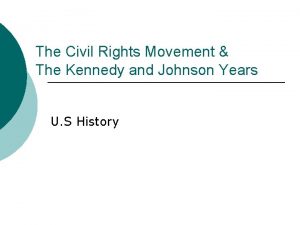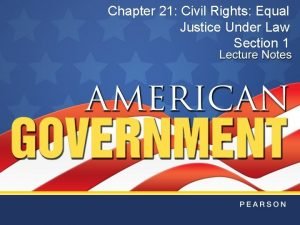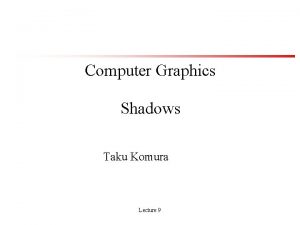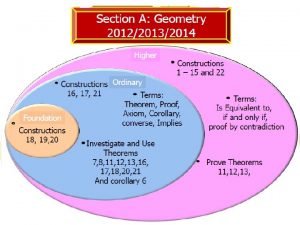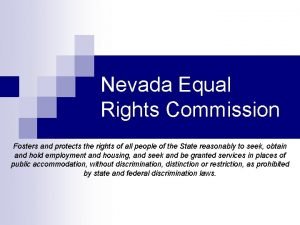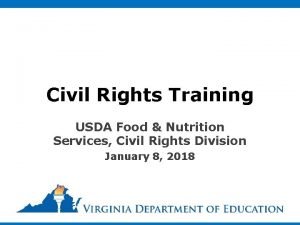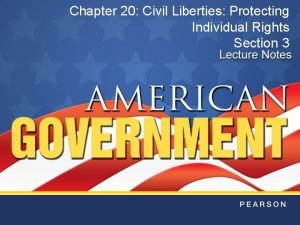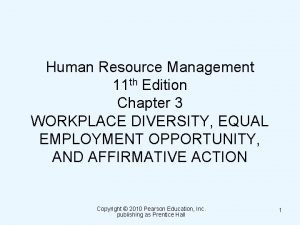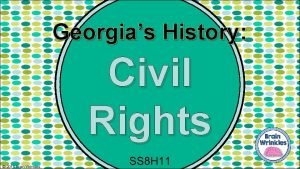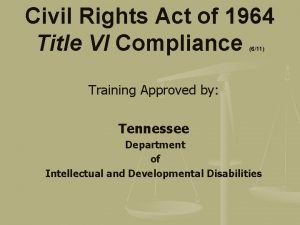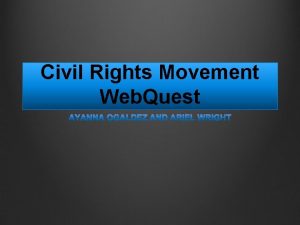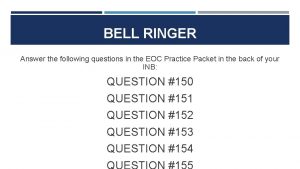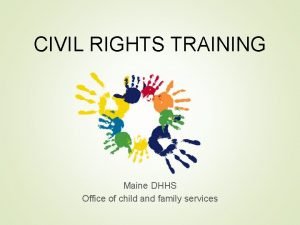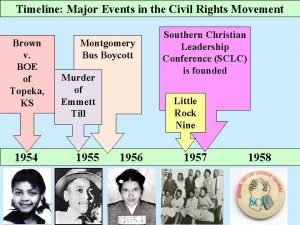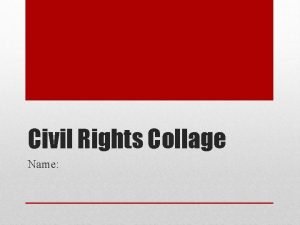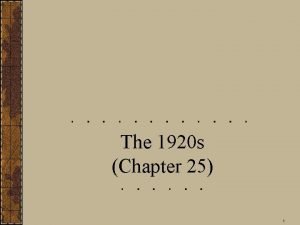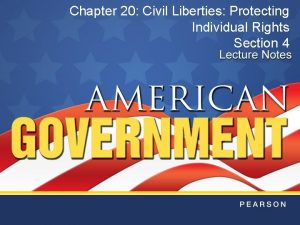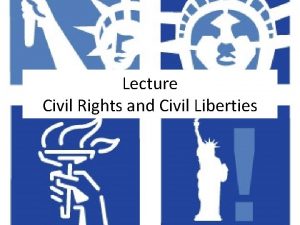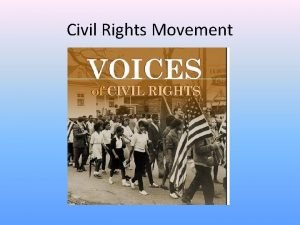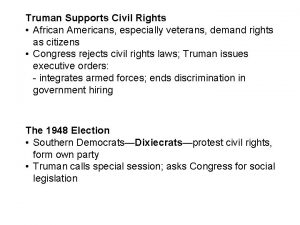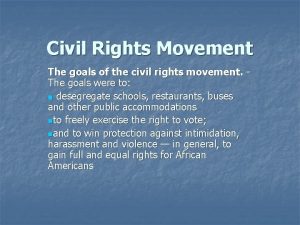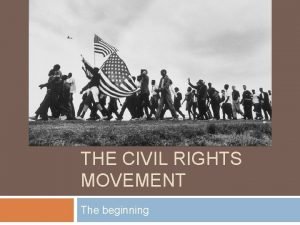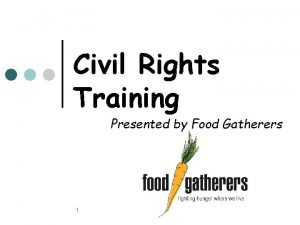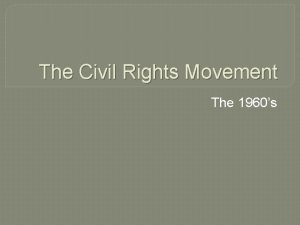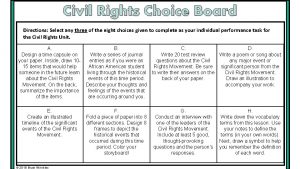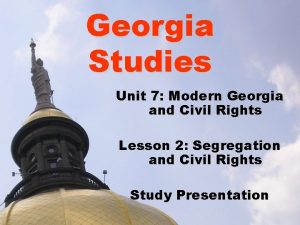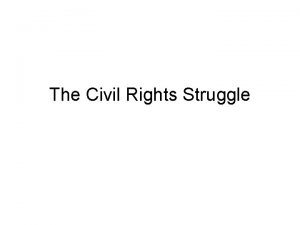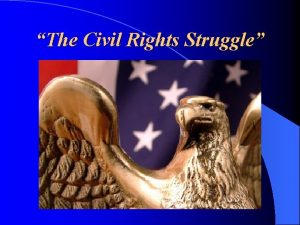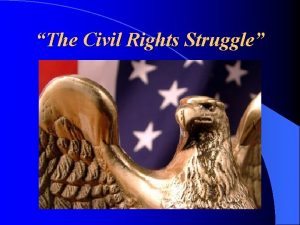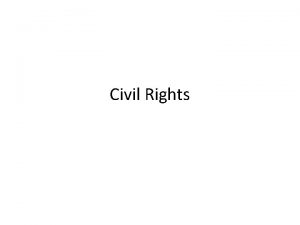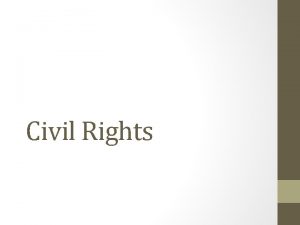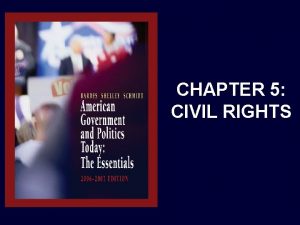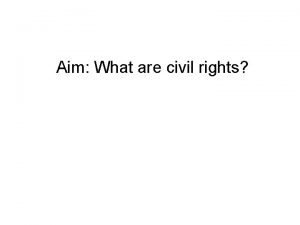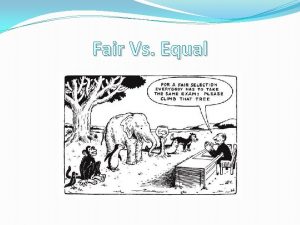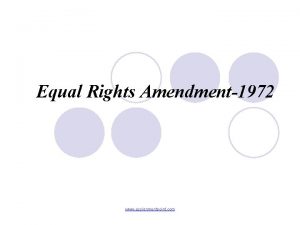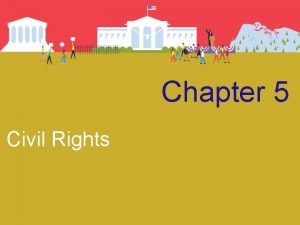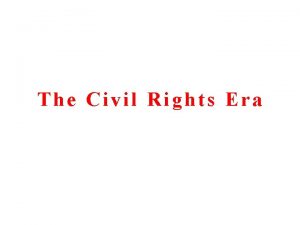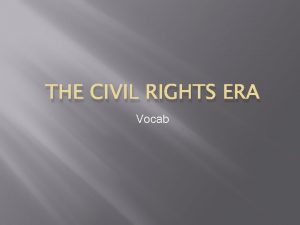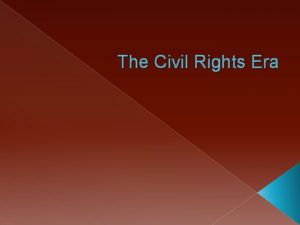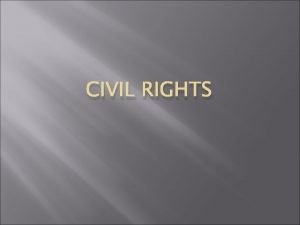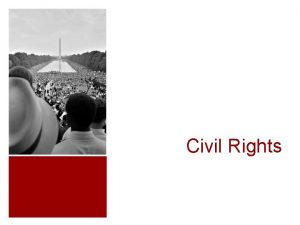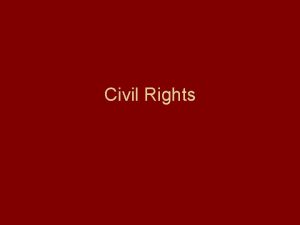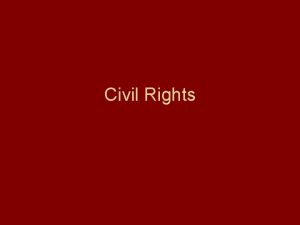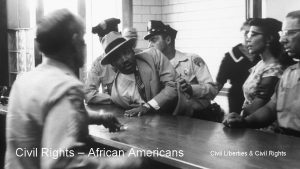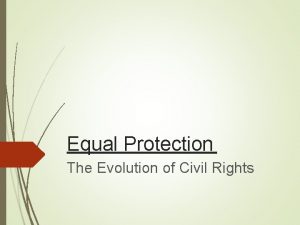The Civil Rights Era Struggle for Equal Rights






































- Slides: 38

The Civil Rights Era

Struggle for Equal Rights Many groups struggled for Civil Rights – including women, the young, African Americans, Mexican Americans, Native Americans – and became vocal about their demands for a more equal and diverse American society

Civil War Amendments • After the Civil War: - 13 th Amendment – (1865) abolished slavery - 14 th Amendment – (1868) provided for equal protection under the law and gave those born in US citizenship - 15 th Amendment – (1870) gave former male slaves suffrage (right to vote) These amendments to the Constitution = foundation of the Civil Rights Movement of the Twentieth Century

Brown v. Board of Education, 1954 • After the Civil War: Southern states passed laws requiring segregation of races in public places, including schools • These types of laws called “Jim Crow” laws or “Black Codes” - all had the purpose of limiting civil rights • Civil Rights won in large part through litigation (resolving disputes in court) • Many cases decided by the Supreme Court

Plessy v. Ferguson, 1896 • Supreme Court decision “Plessy v. Ferguson” upheld the constitutionality of segregation laws (said segregation IS legal) • Homer Plessy: 7/8 th white & 1/8 th black; by Jim Crow laws of Louisiana was considered black; had to ride in a separate train car • Plessy arrested for violating the law; case went before Supreme Court • Court ruled: separate but equal WAS constitutional; and states could legally provide segregated facilities to different races, so long as they were equal in quality. • For 50+ years this is how America handled race.

Plessy vs Ferguson • Court ruled: - separate but equal WAS constitutional (legal under the constitution) - states could legally provide segregated facilities to different races as long as they were equal in quality For more than 50 years this is how America handled race issues

The Truman Years, 1945 -1953 • 1947: Jackie Robinson, the grandson of a slave, became the first African American to play professional baseball • “ 42” opened the door for many African Americans & other minorities in different fields (sports, entertainment, business) • 1948: Truman issued executive order that desegregated the US military; ended discrimination in hiring practices by federal government

Sweatt v. Painter, 1950 • Sweatt v. Painter: case won by NAACP involving the right of Herman Sweatt, an African American, to attend Law School at the University of Texas • UT had even created a separate law school for African Americans, just to keep Sweatt out • Supreme Court ruled this separate school failed to qualify as “separate but equal” since it isolated its students

‘Separate but Equal’ ?

NAACP Challenges ‘Separate But Equal’ • 1953: NAACP challenged a Kansas court ruling that denied African American students admission to an all -white school • NAACP alleged that segregated schools denied African American children equal protection of the law due to them under 14 th Amendment • Segregated schools were inherently inferior b/c that sent message minorities were not good enough to be educated with others

The Brown Decision 1954: Thurgood Marshall argued case for NAACP that Linda Brown, an African American girl, should be allowed to attend a white school closer to her home Chief Justice Earl Warren wrote the unanimous decision for the Supreme Court Brown v. Board of Education decision overturned Plessy v. Ferguson decision; ended legal segregation in public schools Linda Brown Thurood Marshall became first African American on Supreme Court

Montgomery Bus Boycott, 1955 -56 1955: Rosa Parks refused to give up her seat on a Montgomery, Alabama, bus to a white passenger • Alabama’s “Jim Crow” laws made this illegal; she was arrested • Dr. Martin Luther King Jr. led a nonviolent boycott of the bus line that lasted for 13 months • The non-violent boycott worked; court ruled that the bus line had violated the equal protection clause of the 14 th Amendment

Civil Rights Act, 1957: Eisenhower passed Civil Rights Act to increase African American voter participation in the south • Various Jim Crow laws had limited the ability of blacks to vote without paying a poll tax or passing a literacy test • Act created a Civil Rights Commission giving federal courts power to register African American voters • Registration procedures = so complex that the act proved to be ineffective, but it helped set the pattern for later civil rights legislation

The Little Rock Nine • Southern states delayed putting the Brown decision into action • Arkansas Governor Orval Fabus ordered the Arkansas National Guard to surround Little Rock’s Central High to prevent 9 African American students from enrolling • Eisenhower ordered federal troops to Little Rock to ensure they could safely attend school • Gov. Fabus closed the school until the courts forced its reopening

Southerners Resist Integration • Southern Democrats in Congress banded together to stop passage of Civil Rights laws 1963: Alabama Gov. George Wallace stood in the doorway of University of Alabama to prevent blacks from enrolling 1964: Lester Maddox, a white restaurant owner, wielded an axe at African Americans wanting to enter his whites-only restaurant. Maddox was later elected the governor of Georgia.

Sit-ins and Freedom Rides, 1960 -61 1960: four African American students, the Greensboro Four, held a sit-in at a “Whites-Only” lunch counter in North Carolina. Non-violent sit-ins spread 1961: interracial groups rode buses in Freedom Rides in the south to stop segregation Result of non-violent protests = lunch counters desegregated and federal government was forced to help

MLK’s “Letter from a Birmingham Jail” • MLK emerging as the leader of the Civil Rights Movement; uses non-violence to resist unjust laws & violence • King followed in Gandhi’s steps; practiced civil disobedience; Everyone has a moral responsibility to disobey unjust laws” • When MLK led a march in Birmingham, Alabama, he was arrested and jailed • In his “Letter from a Birmingham Jail” MLK explained why blacks could no longer wait patiently for their rights

The March on Washington, 1963 • 1963: to gain support for a Civil Rights bill that was before Congress MLK led a March on Washington • Largest demonstration for human rights in history • King gave his famous “I Have a Dream” speech • King would later meet with JFK • A few months later JFK was killed, but there was a new willingness in Congress to pass legislation for Civil Rights

Civil Rights Act of 1964 • 1963: JFK assassinated; LBJ becomes president • LBJ pushed through new legislation on civil rights • 1964: Civil Rights Act of 1964 is signed into law by LBJ • The law would: “prohibit discrimination based on race, color, religion, or ethnic background in hotels, restaurants, and all places of employment doing business with the federal government”

Struggle for Voting Rights • 1964: Twenty-Fourth Amendment eliminated poll taxes in federal elections (can’t charge to vote) • 1965: Selma Marches: MLK led marches in Selma, Alabama, to demand voting rights for African Americans; demonstrators attacked by police • 1965: Voting Rights Act of 1965 LBJ signed bill into law that ended poll taxes and led to an increase in number of black voters

Increasing African American Militancy • Demand for change was very strong among young African Americans • Civil Rights Movement had ended public segregation in schools (Brown V. Board of Education) & By any means discrimination in voting, but it had not necessary provided for completely equal opportunities • Many young African Americans did not believe that MLK’s non-violent methods were powerful enough • The new militants believed in Black Power to free themselves

The Black Power Movement • 1960 s: many African Americans began to search for the roots of their culture • Celebrated African & African American culture; “Black is Beautiful” became slogan; grew Afros & wore fashions based on African cultures • New groups emerged to provide leadership of traditional non-violent methods (MLK) AND radical groups that advocated violence (Malcolm X, Black Panthers)

The Black Power Movement Non-Violent Organizations • MLK preached non-violence • NAACP: Civil Rights organization • Student Non-Violent Coordinating Committee (SNCC) Radical Organizations • Malcolm X “by any means necessary” • Black Muslims: said Islam should be the religion of all African Americans • Black Panthers demanded right to determine their own destiny

Ghettos Erupt, 1968 • In northern cities African Americans faced segregation in housing; whites often refused to sell homes to them • Many blacks forced to live in inner city slums called ghettos • 1968: MLK assassinated by white supremacist in Memphis • Anger and grief sparked riots across the nation; took dozens of lives • A lack of jobs, urban poverty, and racism = main causes behind riots

Chicano Movement • Mexican Americans, or Chicanos, faced discrimination, racism, and exploitation in 1960 s America • Chicano Movement emerged; focused on rights for farm workers, voting and political rights • Hector P. Garcia, a WWII veteran, became a Civil Rights leader when he noticed that Mexican Americans were often barred from restaurants, voting, hospitals, swimming pools, & had limited employment opportunities

Cesar Chavez and Dolores Huerta • Cesar Chavez organized migrant farm workers in California -supported farm worker rights; demanded increased wages and better working conditions -led migrant workers in non-violent boycott (refused to pick grapes) • Dolores Huerta joined with Chavez to form the United Farm Workers (UFW) to gain increased rights -Huerta later worked for women’s rights, immigration reform, & environmental protection

Chicano Mural Movement • Mexican Americans expressed themselves through art • Using Mexican artist Diego Rivera as a model, they began painting murals in barrios throughout the southwest • The Chicano Mural Movement became an important way to support identity and justice in Mexican American communities • Murals put a face on those who often lacked representation

Segregation of Hispanics in Texas 1950: avg yrs of education of people over 25 people w/Hispanic last names = 3. 5 yrs (27% had NO schooling at all) people considered “Caucasian” = 10. 3 yrs

Delgado vs Bastrop ISD -Until late 1940 s: TX public education system: segregated campuses; Hispanic children separated from Caucasian children 1948: Gus Garcia & LULAC file suit against Bastrop ISD & 3 other districts (say segregation of Hispanic children = illegal b/c part of “white race”) 1949: US District Court agrees; orders desegregation 1956: Driscoll ISD had been forcing all Hispanic-descent students to repeat 1 st grade for three years -Linda Pérez put in the "Mexican" first grade to learn English; she spoke no other language besides English Court decision prohibited segregation of Mexican-American students in public schools; took years to actually put into practice

Lyndon B. Johnson -Born in TX Hill Country; grew up in Johnson City -Graduated from Southwest Texas State Teachers College (now Texas State University) 1928: taught at tiny Hispanic school in Cotulla, TX "The children of Mexican-Americans have been taught that the end of life is a beet row, or a spinach field, or a cotton patch. So to their parents throughout the land, we say, help us lift the eyes of our children to a greater vision of what they can do with their lives. "

American Indian Movement - AIM -Civil Rights Act of 1964: prohibited discrimination against Native Americans but many still felt they were being mistreated by the government -Using the slogan “Red Power, ” the American Indian Movement was founded to gain respect for their heritage and civil rights -AIM temporarily occupied monuments at Wounded Knee, SD, and Alcatraz

Affirmative Action, 1965: LBJ signs Executive Order requiring employers with federal government to take positive steps to increase minority employees; women added later • Affirmative Action programs increased number of minorities in colleges & businesses; some said this was a form of reverse discrimination • “Regents of U. of California v. Bakke” Supreme Court upheld affirmative action but NOT use of racial quotas

Billy Graham • Outspoken supporter of civil rights • Christian preacher and spiritual advisor to several presidents • Became an opponent of segregation and paid to get MLK out of jail • Advised Eisenhower to send troops to protect the Little Rock Nine

STAAR Review Question Which event should be included on timeline? A. B. C. D. Rosenbergs Executed for Spying JFK elected president Vietnam War Ends March on Washington

STAAR Review Question This newspaper headline was a direct result of which of the following events? A. MLK organizes March on Washington B. Jackie Robinson becomes 1 st African American to play professional baseball C. Supreme Court hands down Brown v. Board of Education D. Little Rock Nine banned from Arkansas high school

STAAR Review Question The following quote was taken from which Supreme Court decision? A. B. C. D. Plessy v. Ferguson Roe v. Wade Delgado v. Bastrop ISD Brown v. Board of Education “We conclude that in the field of public education the doctrine of “separate but equal” has no place”. --Warren Court Decision 1954

STAAR Practice The map shows that African American voter registration increased dramatically from 1961 to 1966. What was a primary reason for this increase? 1. 2. 3. 4. Voting Rights Act of 1965 Title IX Immigration Act of 1965 Brown v. Board of Education

STAAR Practice Which Supreme Court decision attempted to end the issue show on the graphic? 1. 2. 3. 4. Roe v. Wade Title IX Plessy v. Ferguson Brown v. Board of Education
 Deficit spending
Deficit spending Chapter 21 civil rights equal justice under law
Chapter 21 civil rights equal justice under law Civil rights webquest
Civil rights webquest Taku graphics
Taku graphics Equal sharing is called
Equal sharing is called Theorem vertically opposite angles
Theorem vertically opposite angles Equal height equal light
Equal height equal light Meridionalnet
Meridionalnet Kara jenkins nevada
Kara jenkins nevada Chapter 20 civil liberties protecting individual rights
Chapter 20 civil liberties protecting individual rights Usda civil rights training
Usda civil rights training Chapter 20 civil liberties protecting individual rights
Chapter 20 civil liberties protecting individual rights Title vii of the civil rights act
Title vii of the civil rights act Civil rights cloze notes 1
Civil rights cloze notes 1 Title vi of the civil rights act of 1964
Title vi of the civil rights act of 1964 Civil rights graphic organizer
Civil rights graphic organizer Civil rights movement essential questions
Civil rights movement essential questions Kerner commission apush
Kerner commission apush Civil rights movement webquest
Civil rights movement webquest Civil rights bell ringers
Civil rights bell ringers Civil rights training child nutrition programs
Civil rights training child nutrition programs Title vii of the civil rights act
Title vii of the civil rights act Brain wrinkles answer key
Brain wrinkles answer key Civil rights timeline of events
Civil rights timeline of events Civil rights in child nutrition programs
Civil rights in child nutrition programs Civil rights collage
Civil rights collage Chapter 14 postwar prosperity and civil rights
Chapter 14 postwar prosperity and civil rights Chapter 20 civil liberties protecting individual rights
Chapter 20 civil liberties protecting individual rights Define civil rights
Define civil rights Civil rights movment
Civil rights movment Truman supports civil rights
Truman supports civil rights Civil rights movement goal
Civil rights movement goal The civil rights movement
The civil rights movement Federally protected classes
Federally protected classes Civil rights sitins
Civil rights sitins Civil rights movement vocabulary
Civil rights movement vocabulary Civil rights choice board
Civil rights choice board Unit 7 modern ga and civil rights
Unit 7 modern ga and civil rights What did the civil rights act of 1875 do
What did the civil rights act of 1875 do
